 W
WNew Sweden was a Swedish colony along the lower reaches of the Delaware River in America from 1638 to 1655, established during the Thirty Years' War when Sweden was a great military power. New Sweden was part of Swedish colonization efforts in the Americas. Settlements were established on both sides of the Delaware Valley in the region of Delaware, New Jersey, New York, and Pennsylvania, often in places where Swedish traders had been visiting since about 1610. Fort Christina in Wilmington, Delaware was the first settlement, named after the reigning Swedish monarch. The settlers were Swedes, Finns, and a number of Dutch. New Sweden was conquered by the Dutch Republic in 1655 during the Second Northern War and incorporated into the Dutch colony of New Netherland.
 W
WThe Block House is a historic building located off Naamans Road in Claymont, Delaware. The Block House is believed to be the only structure remaining of original settlement on Naamans Creek.
 W
WBridgeport is an unincorporated community located within Logan Township, in Gloucester County, New Jersey, United States. The area is served as United States Postal Service ZIP Code 08014.
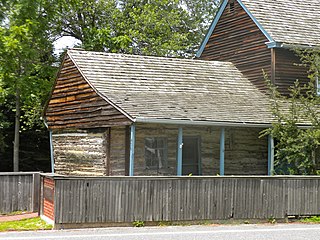 W
WC. A. Nothnagle Log House is a historic house on Swedesboro-Paulsboro Road near Swedesboro in the Gibbstown section of Greenwich Township, Gloucester County, New Jersey, United States. It is one of the oldest surviving log houses in the United States.
 W
WCaesar Hoskins Log Cabin is located in Mauricetown section of Commercial Township, Cumberland County, New Jersey, United States. The building is believed to have been built in 1690s by Swedes for Capt. Caesar Hoskins. It was added to the National Register of Historic Places on September 10, 1987.
 W
WChurchtown, historically known as Penns Neck, is an unincorporated community located north of Pennsville in Pennsville Township, Salem County, New Jersey. St. George's Episcopal Church was started here in 1714 by Swedish and Finnish settlers as a Lutheran church.
 W
WDouglassville is a census-designated place (CDP) in Amity Township, Berks County, Pennsylvania, United States. Douglassville is situated along U.S. Route 422 and Pennsylvania Route 724. Developments include the Amity Gardens subdivision, the West Ridge subdivision, the Briarwood subdivision, and the High Meadow subdivision. Douglassville also includes Cider Mill and the Woods Edge subdivision along Pennsylvania Route 562. As of the 2010 census the population of the CDP was 448 residents.
 W
WElk Landing is the name of a historic home located at Elkton, Cecil County, Maryland. The house at Elk Landing was listed on the National Register of Historic Places in 1984.
 W
WFinns Point is a small strategic promontory in Pennsville Township, Salem County, New Jersey, and New Castle County, Delaware, located at the southwest corner of the cape of Penns Neck, on the east bank of the Delaware River near its mouth on Delaware Bay. Due to the wording of the original charter defining the boundaries of New Jersey and Delaware, part of the promontory is actually enclosed within the state of Delaware's border, due to tidal flow and the manner in which the borders between New Jersey and Delaware were first laid out. Therefore, this portion of Finns Point is an exclave of Delaware, cut off from the rest of the state by Delaware Bay. The area is about 10 miles (16 km) south of the city of Wilmington, and directly across the Delaware River from the New Castle area, and the Delaware River entrance to the Chesapeake & Delaware Canal. Pea Patch Island, part of the state of Delaware, sits in the channel of the river facing the promontory.
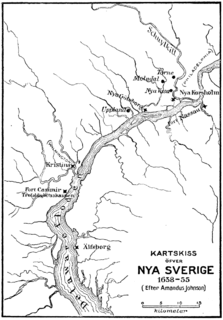 W
WFort Beversreede was a Dutch-built palisaded factorij located near the confluence of the Schuylkill River and the Delaware River. It was an outpost of the colony of New Netherland, which was centered on its capital, New Amsterdam (Manhattan), on the North River.
 W
WFort Casimir or Fort Trinity was a Dutch fort in the seventeenth-century colony of New Netherland. It was located on a no-longer existing barrier island at the end of Chestnut Street in what is now New Castle, Delaware.
 W
WFort Christina was the first Swedish settlement in North America and the principal settlement of the New Sweden colony. Built in 1638 and named after Queen Christina of Sweden, it was located approximately 1 mi (1.6 km) east of the present-day downtown Wilmington, Delaware, at the confluence of the Brandywine River and the Christina River, approximately 2 mi (3 km) upstream from the mouth of the Christina on the Delaware River.
 W
WNew Netherland, or Nieuw-Nederland in Dutch, was the 17th century colony of the Republic of the Seven United Netherlands on the northeastern coast of North America. The claimed territory included southern Cape Cod to parts of the Delmarva Peninsula. Settled areas are now part of the Mid-Atlantic states of New York, New Jersey, Connecticut, Delaware and Pennsylvania. Its capital, New Amsterdam, was located at the southern tip of the island of Manhattan on Upper New York Bay.
 W
WGibbstown is an unincorporated community and census-designated place (CDP) located within Greenwich Township, in Gloucester County, New Jersey, United States. As of the 2010 United States Census, the CDP's population was 3,739. Gibbstown is the location of C. A. Nothnagle Log House, purportedly the oldest house in New Jersey and the oldest surviving log house in the U.S., dating to around 1638.
 W
WGloria Dei Church, known locally as Old Swedes', is a historic church located in the Southwark neighborhood of Philadelphia, Pennsylvania, at 929 South Water Street, bounded by Christian Street on the north, South Christopher Columbus Boulevard on the east, and Washington Avenue on the south. It was built between 1698 and 1700, making it the oldest church in Pennsylvania and second oldest Swedish church in the United States after Holy Trinity Church in Wilmington, Delaware.
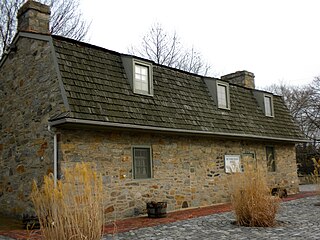 W
WHendrickson House is one of the oldest houses in the U.S. state of Delaware and one of the oldest surviving Swedish-American homes in the United States.
 W
WHoly Trinity Church, also known as Old Swedes, is a historic church at East 7th and Church Street in Wilmington, Delaware. It was consecrated on Trinity Sunday, June 4, 1699, by a predominantly Swedish congregation formerly of the colony of New Sweden. The church, designated a National Historic Landmark in 1961, is among the few surviving public buildings that reflect the Swedish colonial effort. The church is considered part of First State National Historical Park. The church, which is often visited by tourists, remains open today for tours and religious activities.
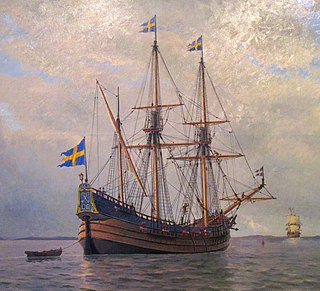 W
WKalmar Nyckel was a Swedish ship built by the Dutch famed for carrying Swedish settlers to North America in 1638, to establish the colony of New Sweden. The name Kalmar Nyckel comes from the Swedish city of Kalmar and nyckel meaning key in Swedish. The name was also a tribute to Kalmar Castle which was a symbol of power during the time of the Swedish Empire when Sweden was a military great power. A replica of the ship was launched at Wilmington, Delaware, in 1997.
 W
WLower Swedish Cabin is an historic Swedish-style log cabin on Creek Road in the Drexel Hill section of Upper Darby, Pennsylvania along Darby Creek. The cabin may be one of the oldest log cabins in the United States.
 W
WMorton Homestead is a historic homestead that is part of Morton Homestead State Park at 100 Lincoln Avenue in Prospect Park, Delaware County, Pennsylvania.
 W
WMortonson-Van Leer Log Cabin, is an historic cabin and one of the last historical dwellings in Swedesboro, Gloucester County, New Jersey, United States. It stands on the grounds of the cemetery of the Trinity Church. It is one of the oldest original log cabins of early Swedish-Finnish architecture in the United States.
 W
WMouns Jones House, also known as the Old Swede's House, is a historic home located in Douglassville, Amity Township, Berks County, Pennsylvania. It was built in 1686, and is a 2 1/2-story, three bay, stone dwelling. It measures 24 ft (7.3 m) by 30 ft (9.1 m) and features a brick chimney for a large, 9 ft (2.7 m) kitchen fireplace. It is the oldest surviving house in Berks County and one of the few remaining examples of a Swedish settler's dwelling. The house was restored by the Historic Preservation Trust of Berks County. It is open to the public periodically during the year as part of the Morlatton Village historic site.
 W
WFort Nya Elfsborg was a fortification and settlement established as a part of New Sweden. Built in 1643 and named after the Älvsborg Fortress off Gothenburg, Fort Nya Elfsborg was located on the New Jersey side of the Delaware River, between present day Salem and Alloway Creek.
 W
WSt. Gabriel's Episcopal Church is an historic Episcopal church located in Douglassville, Amity Township, Berks County, Pennsylvania. The church was founded in 1720 as a Swedish Lutheran church. In 1760 the church joined the Church of England. The oldest structure is known as Saint Gabriel's 1801 Chapel. It was built in 1801, and is a two-story, three bay by two bay, brownstone building. It features a herringbone design in the stone construction. The interior was restored in 1959. It was listed on the National Register of Historic Places in 1978.
 W
WThe Printzhof, located in Governor Printz Park in Essington, Pennsylvania, was the home of Johan Björnsson Printz, governor of New Sweden.
 W
WSt. James Kingsessing, commonly called "Old Swedes," is an historic American church located at 68th Street and Woodland Avenue in the Kingsessing neighborhood of Philadelphia, Pennsylvania. It is one of the churches created by settlers and descendants of the Delaware Valley colony of New Sweden, a colony planted by the Swedish South Company that existed from 1638 and 1655, when it was conquered by the Dutch. St. James, built in 1762, is a sister congregation to the old Swedish church of Gloria Dei in the Southwark neighborhood of Philadelphia.
 W
WSt. Mary Anne's Episcopal Church is an historic Episcopal church building located at 315 South Main Street in North East, Cecil County, Maryland. Built in 1742 of red brick in a rectangular shape to replace an earlier wooden church building on the site, it is the second parish church building for North Elk Parish, later known as St. Mary Anne's Parish, which had been established in 1706 by the General Assembly of the Province of Maryland. Originally dedicated to St. Mary, the parish added Anne to its name in thanks for a bequest it received from the estate of Anne, Queen of Great Britain, who died in 1714. Its bell tower was added in 1904.
 W
WSwedes' Landing is the warehouse road found along the Minquas Kill in Wilmington, Delaware that is close to the Delaware River. This was the site where the initial Swedish landing took place and marks the spot where the New Sweden colony began. The first Swedish expedition to North America, under the command of Peter Minuit, embarked from the port of Gothenburg in late 1637. The members of the expedition, aboard the ships Fogel Grip and Kalmar Nyckel, sailed into Delaware Bay, which lay within the territory claimed by the Dutch West India Company and anchored at a rocky point on Swedes' Landing on March 29, 1638. They built a fort on the site which they named Fort Christina after Queen Christina of Sweden. Today Swedes Landing Road is a short stretch from 4th Street to 7th Street and ends at a long two-story mural depicting the area from the time before the Swedes came through the modern Wilmington waterfront. At the far end of the mural is the entrance to Fort Christina National Historical Site, a part of the First State National Historical Park System.
 W
WSwedesboro is a borough in Gloucester County, New Jersey, United States. As of the 2010 United States Census, the borough's population was 2,584, reflecting an increase of 529 (+25.7%) from the 2,055 counted in the 2000 Census, which had in turn increased by 31 (+1.5%) from the 2,024 counted in the 1990 Census.
 W
WThe Swedish Colonial Society is America's oldest organization dedicated to the study and preservation of New Sweden history. In addition to collecting and publishing research on Swedes and Finns in America, the Society maintains parks, monuments, and memorials of historic sites. A unique aspect of the group is its connection to Sweden's Royal Family and the Swedish government.
 W
WThe Swedish South Company, also known as the Company of New-Sweden, was a trading company from Sweden founded in 1626, that supported the trade between Sweden and its colony New Sweden, in North America. The colony was envisioned by its founding father Willem Usselincx; it was to become the first Swedish transoceanic trading project.
 W
WTrinity Church is a historic church on the northwest corner of Church Street and King's Highway in Swedesboro, in Gloucester County, New Jersey, United States.
 W
WUpland Court was the governing body of the New Sweden colony following Dutch West India Company annexation from Swedish colonial rule. In 1655, Peter Stuyvesant, governor of the Dutch colony, allowed the colonists to remain an independent Swedish nation through Upland Court, allowing freedom of religion, organization of their own militia, while maintaining their land and trading rights. The court typically met at Upland, now known as Chester, Pennsylvania. This location should not be confused with the current borough of Upland, which adjoins Chester. The Upland Court dealt with legal matters on both sides of the Delaware River.
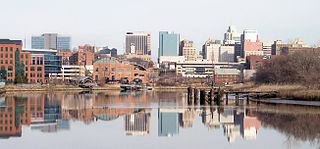 W
WWilmington is the largest and most populous city in the U.S. state of Delaware. The city was built on the site of Fort Christina, the first Swedish settlement in North America. It lies at the confluence of the Christina River and Brandywine River, near where the Christina flows into the Delaware River. It is the county seat of New Castle County and one of the major cities in the Delaware Valley metropolitan area. Wilmington was named by Proprietor Thomas Penn after his friend Spencer Compton, Earl of Wilmington, who was prime minister during the reign of George II of Great Britain.